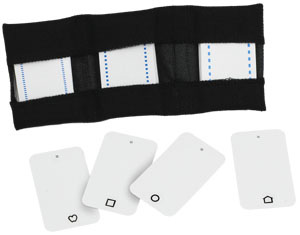LEA SYMBOLS®
Domino Cards
#251500

The set contains 48 domino-like cards with a large symbol at
one end and a small symbol at the other end. The paper cards
measure 4 x 7 cm (1.6 x 2.75 in). The set is divided into three
packs of 16 cards each. One pack has symbols of 3.2M and 0.8M.
The next one has symbols of 2.0M and 0.5M. The last one has
symbols of 1.25M and 0.3M. The back of the cards has the
following notations: Symbol size in M Units, 6 meter equivalent,
20 foot equivalent and decimal visual acuity value at a 40 cm test
distance.

LEA SYMBOLS® Domino Cards
allow the assessment of
visual acuity in children between the ages of two and three. They can
also be used to train an amblyopic eye at any age.
Instructions
Shuffle one pack of LEA SYMBOLS® Domino Cards and
deal the cards equally to each of two or three players. When
introducing the game to a child, you might choose to first play
the cards with the largest symbols and then play the other two
packs. The child lays down the first card (Card #1). The adult
continues the game by laying down a card with the largest symbol
that matches the larger of the two symbols on the card the child
has played (Card #2). Thus, the two largest symbols are placed
side-by-side on the table, and the child has to look at the
smaller symbols to choose the next card.
The adult player should always try to choose a card (Card #4 ) that forces the child to look at the smallest symbols. When there are only a few cards left, the adult player may have to put down a card matching a small symbol. When a player does not have a card with the correct symbol, that player has to pass. The winner is the first player to have played all her cards, or the one who has the fewest cards left at the end of the game.
When the child has learned the game by playing with the largest symbols, the packs of cards with the small symbols may be used. If the adult player is presbyopic, reading glasses will be needed to see some of the smaller symbols.
For amblyopia training, you can start with covering the amblyopic eye with a patch on the lens of the spectacles. Once the child is familiar to play with the Domino Cards -game using the patch on the amblyopic eye, try to play while covering the better, leading eye with the eye patch. To familiarize the child to accept the covering of the leading eye, you may draw small pictures while the child tells you what you should draw.
To get an accurate measurement of a child's visual acuity, the LEA SYMBOLS® Domino Cards-game should be fun.
When the child makes a mistake, the adult can either say nothing,
or say pleasantly, "Well, let's see if these two really match."
Generally, most children are able to follow the rules exactly.
Occasionally, however, a child changes the rules to suit himself. Even so, it is fairly easy to tell whether mistakes are
due to the child's inability to tell the symbols apart or whether
the child does not understand the game.

The LEA SYMBOLS® Domino game is often used to train an amblyopic eye. In this case, the right lens of the girl’s glasses is occluded and the left eye trained. The younger sibling watches the game and will be tested as soon as he has learned to recognize the symbols.

The LEA SYMBOLS® Domino cards are often used at a distance other than 16" (40cm). For calculation of visual acuity values, measure and record the viewing distance and the symbol size (the M value*) or the visual acuity value printed on the cards with the smallest symbols identified correctly.
To determine the visual acuity use one of the following formulas:

For example, if the child saw the 1.6M card at 12cm, the corresponding visual acuity value is 0.12m/1.6M = 0.07 in the decimal system.
When the British notation is used the calculation is based on formula #2: 1.6M corresponds to 6/24 at 40cm distance. Thus 12cm/40cm x 6/24 = 1/40 x 6/2 = 6/80
If a child saw the 1.0M symbols at 5 inches, visual acuity is calculated using the formula #2: 1.M corresponds to 20/50 at 16 inches. Since it was seen at 5 inches, the visual acuity is 5/16 x 20/50 = 1/16 x 20/10 = 20/160
The American and the British notation values are often easier to calculate using the decimal value.
For example 0.07= 7/100= [7x3/100x3]=21/300 or 20/300; for the British notation: 0.07=7/100=6/86.
You multiply both the numerator and the denominator with the number that makes the numerator equal or closely equal to 20 or 6.
It is also adequate to write down the M-value and the distance used. Use the same distance to measure visual acuity of the amblyopic and the leading eye. Then comparison of the acuity values is easy: the difference in visual acuity values as lines of the visual acuity chart is equal to the difference in M-values. Since an amblyopic eye usually sees individual symbols better than symbols in a line test the values measured with the LEA SYMBOLS® Domino Cards show a smaller difference between the eyes than there might be.
To keep the viewing distance constant, you may pretend not seeing the smaller symbol of your card. Show the card to the child at the distance of 16" (40cm). If the child bends forward move the card accordingly. Do not use a ruler to measure the distance but use your arm as the measure stick.
*M-unit, metric unit is the distance in meters at which the reference optotype C is seen at a visual angle of 5'.
[ Instructions I Paediatric Vision Tests I Vision Tests ]
This document was last modified on